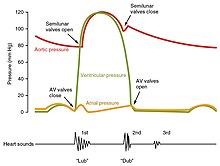Cardiac output
Main article: Cardiac output
Cardiac output (CO) is a measurement of the amount of blood pumped by each ventricle (stroke volume) in one minute. This is calculated by multiplying the stroke volume (SV) by the beats per minute of the heart rate (HR). So that: CO = SV x HR.[7]
The average cardiac output, using an average SV of about 70mL, is 5.25 L/min, with a range of 4.0–8.0 L/min.[7] The stroke volume is normally measured using anechocardiogram and can be influenced by the size of the heart, physical and mental condition of the individual, sex, contractility, duration of contraction, preload andafterload.[7]
Preload refers to how much blood is in the ventricles at the end of diastole, when they are at their fullest. A main factor is how long it takes the ventricles to fill—if the ventricles contract faster, then there is less time to fill and the preload will be less.[7]Preload can also be affected by a person's hydration status.[citation needed]. It is important because of the Frank-Starling mechanism. This states that the force of contraction is directly proportional to the initial length of muscle fiber. This means that a ventricle will contract more forcefully, the more it is stretched.[7]
Afterload, or how much blood is left in the ventricles after systole, is influenced by vascular resistance. This tension is calledafterload. It can be influenced by narrowing of the heart valves (stenosis) or contraction or relaxation of the peripheral blood vessels.[7]
The strength of heart muscle contractions controls the stroke volume. This can be influenced positively or negatively by agents termed inotropes. These can be either conditions or drugs. Positive inotropes that cause stronger contractions include high blood calcium and drugs such as Digoxin, which will act to stimulate the sympathetic nerves in the fight-or-flightresponse. Negative inotropes causing weaker contractions include high blood potassium, hypoxia, acidosis, and drugs such as beta blockers and calcium channel blockers. These act on the parasympathetic nervous system via the vagus nerve.


0 comments:
Post a Comment